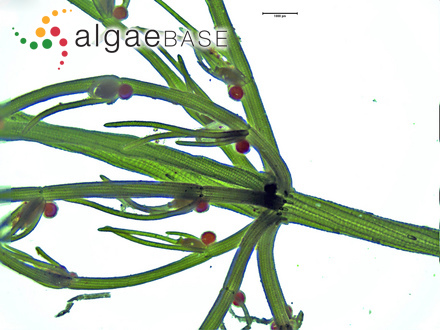Chara vulgaris Linnaeus 1753

Current name:
Chara vulgaris Linnaeus
Yardley Chase, Northamptonshire, UK. - 06 April 2007. C.F.Carter (chris.carter@6cvw.freeuk.com)
Publication Details
Chara vulgaris Linnaeus 1753: 1156
Published in: Linnaeus, C. (1753). Species plantarum, exhibentes plantas rite cognitas, ad genera relatas, cum differentiis specificis, nominibus trivialibus, synonymis selectis, locis natalibus, secundum systema sexuale digestas. Vol. 2 pp. [i], 561-1200, [1-30, index], [i, err.]. Holmiae [Stockholm]: Impensis Laurentii Salvii.
Publication date: 1 May 1753
Type Species
This is the type species (lectotype) of the genus Chara.
Status of Name
This name is of an entity that is currently accepted taxonomically.
Type Information
Type locality: "Habitat in Europeae...". [Europe]; (Linnaeus 1753: 1156) Lectotype (no locality; designated by Wood 1960: 220): LINN; 1088.3 {"2.vulgaris") (Wood 1960: 220) Notes: Syntype: LINN 1088.2
Origin of Species Name
Adjective (Latin), common, general, ordinary (Stearn 1983).
General Environment
This is a freshwater species.
Description
The plants are from 10 to 50 cm high, axis is from 0.5 to 1 mm in diameter, moderately to heavily encrusted, often grey to dark green in colour. The branchlets are 7-9, each with 6-8 segments, of which 2-3 often are ecorticated. The stem cortex is diplostichous and aulacanthous (fig. 6). The spine cells are always solitary, from papillous to as long as the axis diameter (f. papillata). The species is monoecious. The gametangia are conjoined at the 3-4 lowest branchlet nodes. The oogonium is to 900 µm long. The oospores are normally brown, but is black in one of the varieties. The antheridium is up to 500 µm in diameter. Chara vulgaris is a highly polymorphic species, and many forms and varieties have been described.
Habitat
Chara vulgaris is a freshwater species but has also been found in slightly brackish water. The species is found in a large spectre of habitats, ponds, puddles, ditches, rivers, littoral pools and periodical waters. Very few finds are from lakes. It is found both in soft and alkaline water and it grows down to 1 m. Both annual and perennial forms occur. Plants surviving the winter will often give rise to new shoots the next year. Chara vulgaris is often richly fertile.
Created: 11 April 2002 by M.D. Guiry.
Last updated: 20 January 2025
Verification of Data
Users are responsible for verifying the accuracy of information before use, as noted on the website Content page.
Distributional note
Chara vulgaris is cosmopolitan, lacking only in Antarctica (Proctor, 1980). The species is present in every European country (Fig. 52.7), except Finland (Langangen et al., 2002), and up to 67° N (Russia), but its natural range only extends to c. 60° N (Romanov et al., 2018). Very common throughout most of the continent, except in regions with only dilute low-alkalinity waters. It occurs in many island localities but remains absent from Iceland (Hrafnsdottir et al., 2019) and the Faeroes. (denys & al. 2024). - (16 January 2025) - M.D. Guiry
Habitat note
Eutrophication and decrease in the number of suitable habitats as e.g. small water bodies which are drained or filled in. - (26 June 2011) - M.D. Guiry
Conservational note
Chara vulgaris s.l. is one of the commonest charophytes in a large part of Europe and not considered endangered or a Red List species in any Member State of the European Union. Locally, C. vulgaris may suffer from eutrophication or habitat destruction, but its eurytopic/euryecious character and ability to colonise secondary water bodies allow it to persist at a regional scale even where land use is quite intensive. - (16 January 2025) - M.D. Guiry
Usage note
Potential application as pesticide; showed some repellent activity against Culex pipiens pallens (Zhang et al. 2010). - (17 May 2010) - G.M. Guiry
Linking to this page: https://www.algaebase.org/search/species/detail/?species_id=27184
Citing AlgaeBase
Cite this record as:
M.D. Guiry in Guiry, M.D. & Guiry, G.M. 20 January 2025. AlgaeBase. World-wide electronic publication, National University of Ireland, Galway. https://www.algaebase.org; searched on 28 March 2025
 Request PDF
Request PDF














